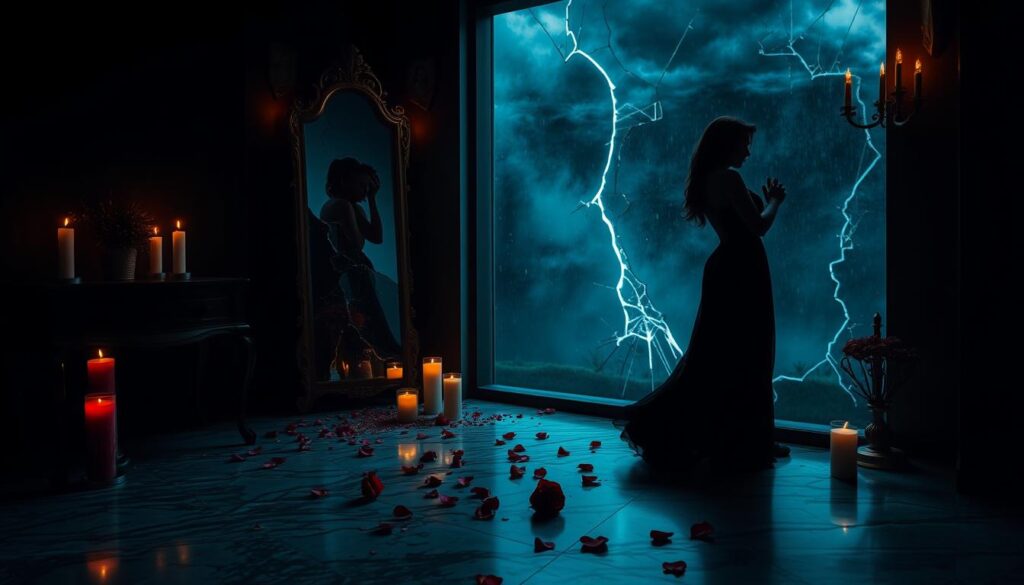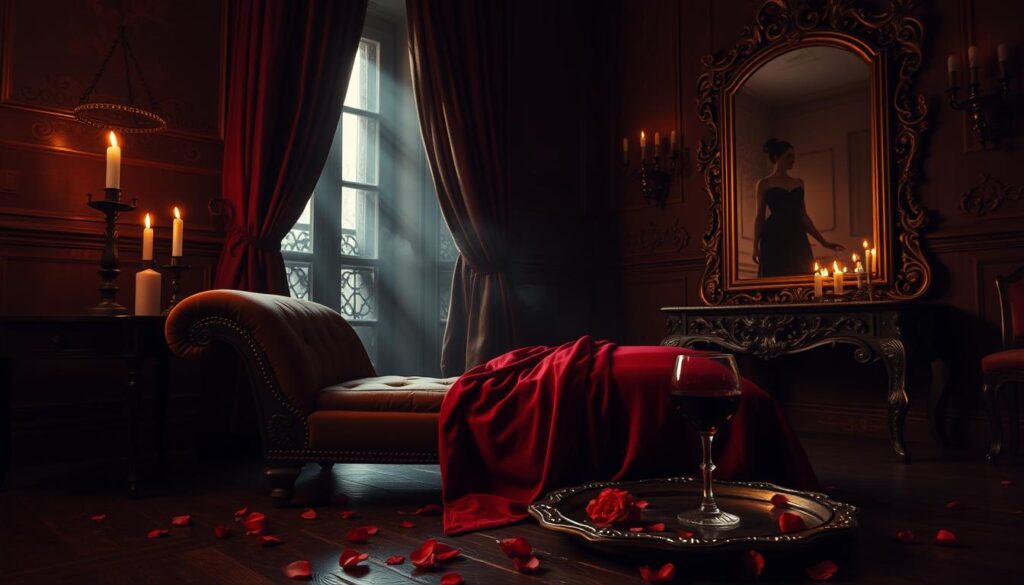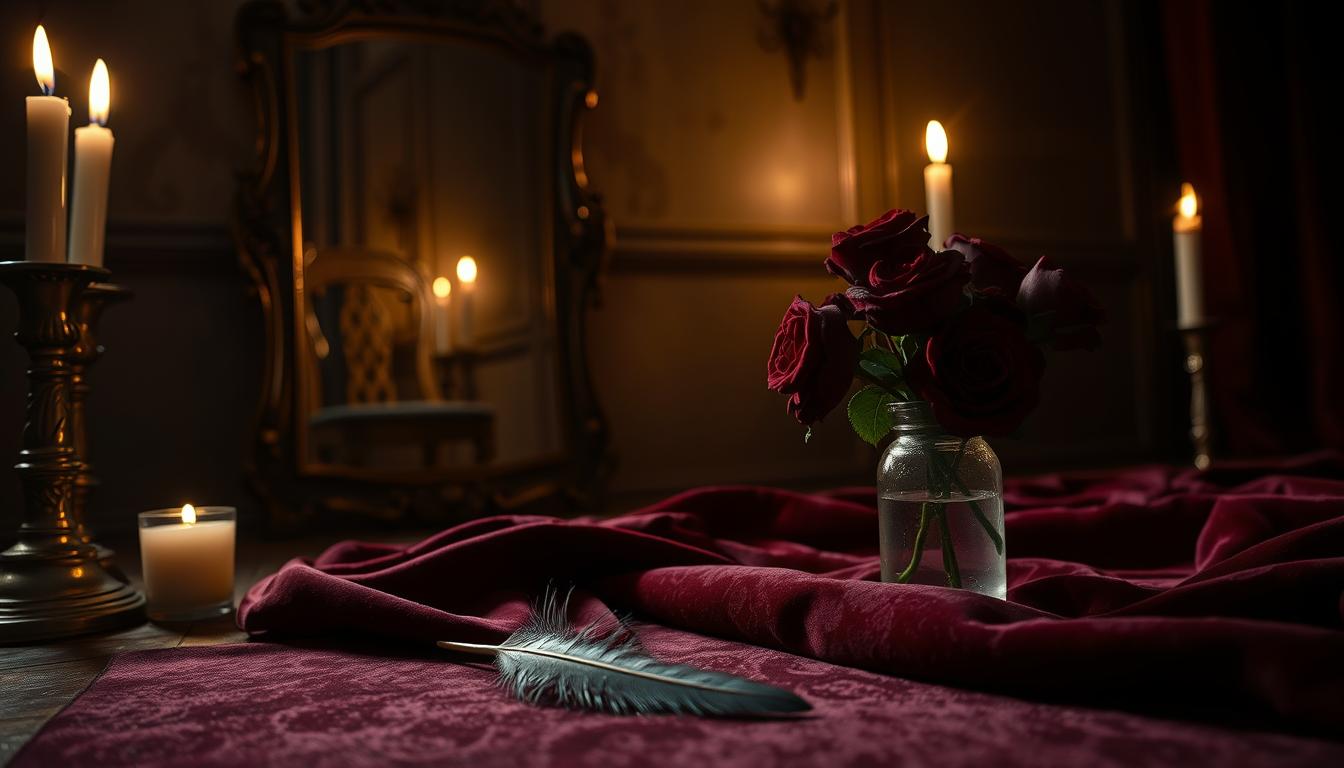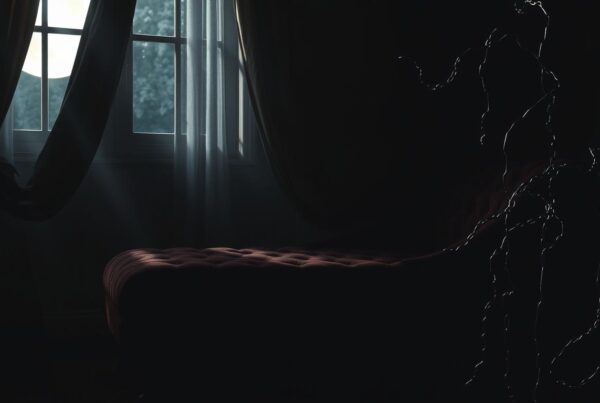Explore the world of psychological dark romance. Here, love and danger mix, creating a thrilling experience. It’s a blend of suspense and romance that keeps you guessing.
Authors in this genre tell stories of complex love set in mysterious worlds. These tales challenge and intrigue, showing the darker side of us.
We’ll learn how to mix love and darkness in our stories. We’ll talk about creating flawed characters and building suspense. This guide will help you write psychological thrillers that grab and unsettle you.
Understanding the Essence of Psychological Dark Romance
The dark romance genre mixes deep passion with psychological depth. It offers a unique reading experience. This mix of love and darkness pulls readers into a world full of deep emotions and hidden dangers.
Defining the Genre’s Unique Characteristics
Psychological fiction in dark romance shows complex characters with inner struggles. These stories dive into the human psyche, combining passionate love with mystery. The genre is known for its morally complex heroes, deep emotional bonds, and unexpected plot twists.
Exploring Psychological Aspects
Dark romance looks into characters’ deepest fears, desires, and reasons. Writers craft stories that show the true, often uncomfortable sides of human nature. This adds depth to the romantic tales, making them emotionally rich and suspenseful.
The Appeal to Readers
Psychological dark romance stirs strong feelings and makes readers think. Fans love the intense relationships, the thrill of danger, and exploring forbidden topics. These stories offer a deep dive into a world where love is everything, and right and wrong are not clear-cut.
Key Elements of Suspense in Dark Romance Writing
Dark romance writers use suspense techniques to keep readers hooked. Foreshadowing is key in building tension. They drop hints about future events, creating unease.
Effective tension building is about pacing. Writers reveal just enough to intrigue without giving too much away. They pose questions or introduce mysteries that demand answers.
Plot twists are crucial in dark romance suspense. Unexpected revelations or sudden story shifts catch readers off guard. These surprises challenge what readers thought they knew.
Dramatic irony adds depth to the suspense. Writers share secrets with readers that characters don’t know. This creates anticipation as readers watch characters face danger or make decisions with incomplete info.
Developing Complex and Flawed Characters
Character development is crucial in psychological dark romance. It’s about making characters deep and complex. This makes readers want to keep reading.
Creating characters with flaws is important. These flawed protagonists and anti-heroes connect with us on a deeper level.
Crafting Multi-Layered Personalities
Writers need to explore their characters’ backstories and quirks. Flawed protagonists face moral dilemmas. This makes them relatable and interesting.
By looking into what drives them, authors add depth. This makes the story richer.
Unveiling Inner Conflicts
Anti-heroes in dark romance deal with inner struggles. These struggles make them unpredictable and captivating. Exploring these inner battles creates tension.
This keeps readers hooked on the character’s journey.
Striking a Balance
The key to character development in dark romance is balance. Flawed protagonists may have bad morals but should also have good qualities. This balance makes characters complex and memorable.
It drives the story and leaves a lasting impression.
Crafting Suspense and Intrigue in Psychological Dark Romance Writing
Mastering suspense writing is key for a gripping psychological dark romance. Writers build intrigue by controlling info flow. They withhold key details and reveal them at the right time to keep readers guessing.
Red herrings are crucial for tension. They are false clues that lead readers astray. This makes the big reveals even more exciting. Authors use these tricks to keep the story moving and full of surprises.
Atmospheric tension is also a powerful tool. Writers create a creepy setting with vivid descriptions. This makes readers feel the dark atmosphere of the story.
Narrative hooks grab and keep reader interest. These elements, like mysterious characters or unexplained events, make readers want to keep reading. They introduce the story’s secrets early on.
Using these techniques, authors can make psychological dark romances that hold readers’ attention. The secret is to balance revealing and hiding info. This keeps readers on the edge of their seats from start to finish.
Building Atmospheric Settings for Dark Romance
The right setting is crucial for a psychological dark romance. Atmospheric writing is key to creating the perfect backdrop. Let’s look at how to craft settings that grab readers and boost your story.
Choosing Evocative Locations
Choose places that evoke feelings and curiosity. A crumbling Victorian mansion, a foggy coastal town, or an isolated cabin in the woods are great. The time period also matters. Historical settings add depth, while modern ones feel eerily familiar.
Creating Mood with Sensory Details
Make your setting come alive with vivid descriptions. Use all five senses to pull readers in. The creak of old floorboards, the scent of damp earth, or the taste of salt in the air can create a haunting atmosphere. These details are key for mood creation in your story.
Incorporating Symbolic Elements
Weave symbolism into your setting. A wilting rose garden might symbolize fading love, while a locked attic could represent hidden secrets. These subtle touches add layers to your story and deepen the psychological impact on readers. By mastering these techniques, you’ll create unforgettable settings that draw readers into your dark romance world.
Mastering the Art of Foreshadowing
Foreshadowing is key in psychological dark romance. It makes readers excited and happy when they figure things out. Writers hide clues in their stories to keep readers guessing.
Symbolic objects or events are great for foreshadowing. A simple item can turn out to be very important later. This makes the story feel connected and rewards those who pay close attention.
Dialogue is also a strong tool for foreshadowing. Characters might share clues in everyday talks. These hints might seem small at first but become big as the story goes on.
Atmosphere can hint at what’s coming. Dark weather or creepy settings can suggest bad things ahead. This adds to the story’s depth and prepares readers for surprises.
How characters act or react can also hint at future events. A character’s strange fear or interest might mean something big is coming.
Getting good at foreshadowing makes stories better. It creates a deep, engaging story that keeps readers hooked from the beginning to the end.
Techniques for Creating Psychological Tension
Writers of psychological dark romance use many ways to keep readers on edge. These methods build suspense and make the story hard to stop reading.
Internal Monologue and Unreliable Narrators
Internal monologue lets readers see into characters’ minds, raising tension. Unreliable narrators add mystery, making readers wonder what’s real. This mix keeps readers guessing and hooked on the story.
Plot Twists and Unexpected Revelations
Plot twists surprise readers when they least expect it. These sudden turns create excitement and make the story unpredictable. Unexpected revelations about characters or events can change the story’s direction.
Balancing Action and Introspection
Good narrative pacing mixes action scenes with quiet moments. This balance keeps readers interested while they process intense events. It’s key to keeping tension throughout the story.
By mastering these techniques, writers can create compelling psychological dark romances. The mix of internal struggles, surprising turns, and carefully paced storytelling makes for an unforgettable read.
Exploring Taboo Themes in Dark Romance

Dark romance writers explore new areas, tackling taboo subjects. These themes add depth and intrigue to stories. They captivate readers with their boldness.
They delve into forbidden relationships and complex power dynamics. Authors look at the darker side of human nature.
When tackling sensitive topics, writers must be careful. They need to consider ethics while keeping the genre’s edge. This balance ensures the themes add to the story without being too much.
Dark romance lets authors challenge societal norms. By tackling taboo subjects, they create stories that make readers think. These stories often lead to discussions about morality, consent, and psychology.
Authors must research and approach sensitive topics with respect. This approach helps avoid harmful stereotypes. It makes the stories compelling and respectful.
Writers who handle taboo subjects well create unforgettable stories. They leave a mark on readers. By exploring controversial themes, they keep the genre exciting for those who love bold stories.
The Role of Pacing in Sustaining Suspense
Narrative pacing is crucial for keeping readers excited. In psychological dark romance, it’s essential. It can turn a story into a thrilling page-turner or a boring read. Let’s look at how pacing helps build and keep suspense in your story.
Varying Sentence and Paragraph Length
Use short, sharp sentences and longer ones to create a rhythm. Short paragraphs speed up the pace. Longer ones slow it down. This method controls the emotional feel and keeps readers interested.
Strategic Use of Cliffhangers
End chapters with a twist or big reveal to keep readers eager. But, don’t overuse cliffhangers. Too many can feel forced. Use them at key moments for the best suspense.
Balancing Tension and Release
Switch between slow tension and big climaxes. Build suspense slowly, then release it with action or a big reveal. This creates a thrilling emotional ride for your readers.
Effective pacing is more than speed. It’s about matching the emotional journey of your characters. By mastering these techniques, you’ll create a captivating psychological dark romance that keeps readers hooked from start to end.
Crafting Dialogue that Heightens Intrigue
Dialogue is key in psychological dark romance. It makes characters real and deepens the story. Good dialogue shows who the characters are, moves the plot, and builds tension.
Through dialogue, characters interact in suspenseful ways. Writers can suggest hidden motives or secrets with subtext. This keeps readers guessing and wanting to know more.
Creating unique voices for each character is important. It helps readers connect with them. This makes the story more engaging.
Revealing information through dialogue is an art. It’s about knowing what to share and when. This keeps readers curious and eager to keep reading.
Dialogue can also show what’s going on inside a character’s mind. Short answers might show fear or tension. Long speeches could hide something or show nervousness. Paying attention to these details makes conversations rich and engaging.
Incorporating Psychological Theories in Your Writing
Psychological theories are key in making dark romance stories come alive. They help writers add depth to their tales. This way, they can explore the human mind’s complexities.
Understanding Common Psychological Disorders
To make characters believable, writers must know about common mental health issues. This knowledge helps them show mental health in fiction accurately. They can research conditions like anxiety or depression to make character struggles real.
Applying Psychological Concepts to Character Development
Believable characters start with good character psychology. Writers can use theories like attachment or cognitive dissonance. This makes characters’ actions and thoughts more interesting and layered.
Ethical Considerations in Portraying Mental Health
Writing about mental health needs to be done with care. Avoid using stereotypes or making things too dramatic. Instead, aim for honest and respectful portrayals. Talk to mental health experts or people who have gone through these issues to make sure your depiction is fair and kind.
By using psychological theories wisely, writers can craft stories that touch readers. It’s important to be true to the subject matter but also to be gentle. This way, your work can help spark important discussions about mental health in fiction.
Balancing Romance and Darkness in Your Narrative

Creating a captivating psychological dark romance is all about balance. You need to mix tender moments with sinister undertones. This balance makes the story thrilling and emotionally deep.
Relationship dynamics are key in any romance novel. But in dark romance, they’re even more complex. Characters might face trust issues, past traumas, or conflicting desires. Exploring these emotions makes the story more intense and engaging.
To keep the genre balance, mix romantic scenes with darker plot points. This mix of emotions keeps readers hooked. It makes them care about both the love story and the danger.
The success of a psychological dark romance comes from mixing light and shadow. Aim to create tender moments in the darkest scenes. This contrast makes your story unforgettable and leaves readers wanting more.
The Importance of Research in Psychological Dark Romance
Creating a gripping psychological dark romance needs more than just imagination. It requires deep writing research to make your story believable. Let’s look at how to make your story stand out with credibility.
Conducting Thorough Background Research
Dive into psychological topics related to your plot. Read academic journals, psychology textbooks, and case studies. This knowledge helps you create realistic characters and scenarios. Fact-checking is key to avoid common misconceptions about mental health.
Interviewing Experts and Gathering Real-Life Experiences
Expert interviews offer invaluable insights for your story. Talk to psychologists, therapists, or other professionals in the field. Their real-world experiences add depth to your narrative. Always respect confidentiality and ethical guidelines during these discussions.
Incorporating Authentic Details
Use the information you’ve gathered to add authentic details to your story. This could include accurate descriptions of psychological symptoms, therapy sessions, or the impact of mental health on relationships. These elements make your psychological dark romance believable and keep readers hooked.



